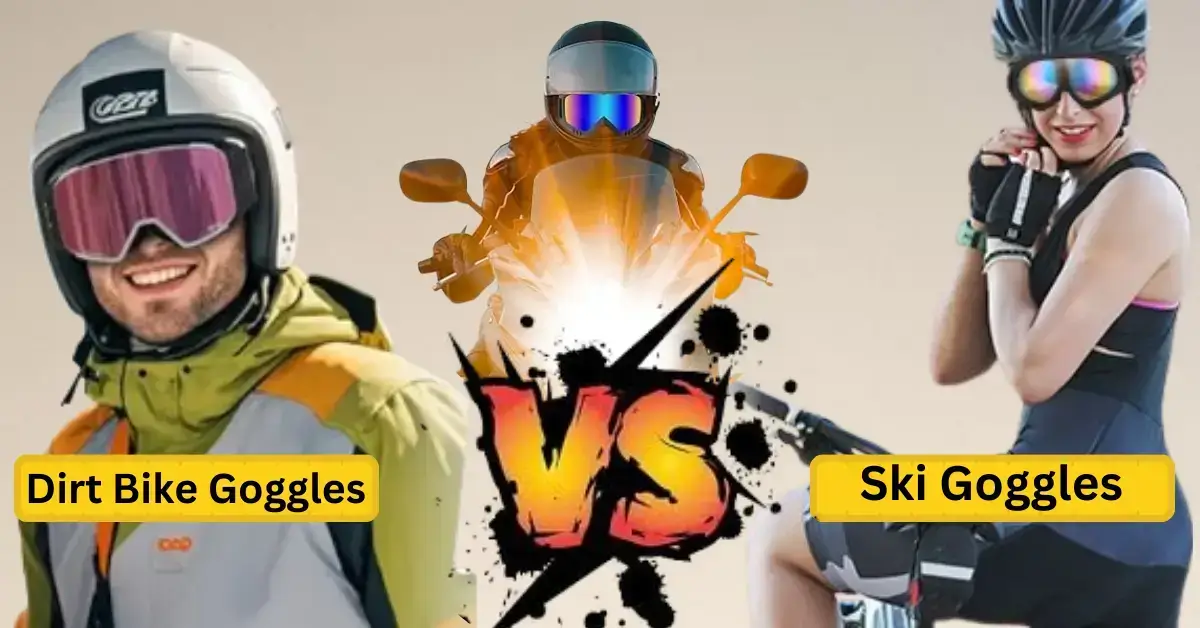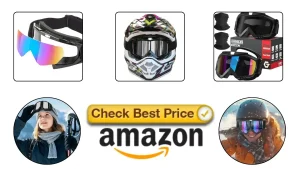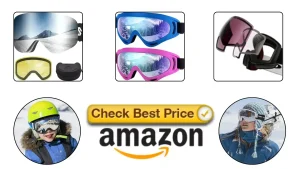Ever grabbed your gear and wondered if your goggles would work for both the slopes and the dirt trails? I’ve been there. It’s tempting to use one pair for both skiing and riding, but it’s not that simple. After testing both types across seasons, I’ve learned where they shine—and where they fall short. If you’ve ever asked yourself whether dirt bike goggles can handle snow or if ski goggles can take a ride through the mud, you’re in the right spot. Let’s clear up the fog and break it all down.
Dirt Bike Goggles Review

I’ve been using dirt bike goggles for years on all kinds of rides—dusty trails, muddy tracks, and long off-road days. Here’s what I’ve learned from real-world use, not just specs on paper.
What I Like
Here’s what stood out to me the most after using different dirt bike goggles regularly.
- Incredible Comfort – The triple-layer foam on most goggles feels like a soft cushion on your face. I’ve ridden for hours without that annoying pressure or irritation.
- Wide Field of View – I genuinely appreciate how modern designs offer a broad, unobstructed field of vision. It’s like turning up the brightness and widening the lens of your world.
- UV Protection & Anti-Fog Lenses – I ride in all weather, and these lenses hold up beautifully. They keep the sun from blinding me and don’t fog up, even when the trail gets intense.
- Helmet Compatibility – I’ve tested goggles with and without outriggers, and I like how easily most models fit different helmets snugly without compromising seal or comfort.
- Durability in Harsh Conditions – Whether it’s mud, dust, or rain, these goggles hold their own. They’ve survived more than a few rough spills without cracking or warping.
- Easy Lens Swaps – I love that I can switch from clear to tinted lenses in a snap. It saves space, time, and hassle.
What Could Be Better
Nothing’s perfect—but that doesn’t mean it’s a deal-breaker. Here are a few areas where I see room to grow.
- Fit Can Vary – Depending on your helmet or face shape, not every pair fits perfectly right out of the box. It took me a few tries to find my ideal match.
- Premium Features = Premium Price – Some of the top-tier goggles come at a higher price point. They’re worth it, but budget-conscious riders might hesitate at first.
- Lens Locking Systems Can Be Stiff – Quick-change lens systems are great once you get used to them, but some brands use mechanisms that feel a bit rigid at first.
- Ventilation Trade-offs – More airflow means better fog prevention, but on colder days, it also means a chilly ride. It’s a balance I’ve learned to work around.
My Personal Experience
I’ve been riding off-road for nearly five years now, through mud, mountain trails, and sand. I’ve used goggles from multiple brands, testing their comfort, durability, and clarity on all kinds of terrain.
Design
Let’s talk about how these goggles look and feel on your face and helmet.
I’ll be honest—design matters more than we like to admit. Dirt bike goggles have come a long way. I’ve been impressed by how some brands combine sleek looks with rugged functionality. The frameless and semi-rim designs don’t just look cool; they give a better field of view too. Straps with vibrant colors and wide silicone linings help with grip and style. I’ve gotten compliments mid-ride—and that’s rare out on dusty trails!
Performance
Because when you’re racing or riding, your gear needs to work with you, not against you.
Performance is where these goggles really shine. I’ve ridden in foggy forests, hot deserts, and muddy backtrails—visibility stayed sharp and constant. Tear-off posts are a huge plus during races, and anti-fog coatings actually work. The clarity in lenses like Oakley’s Prizm or 100%’s HiPER makes reading terrain faster and safer. It’s like the goggles anticipate the ride with you.
Build Quality
If it can’t take a beating, it’s not coming on the trail with me.
The build quality of today’s best dirt bike goggles is impressive. I’ve dropped them, shoved them in backpacks, and even had them flung off during a crash—and they held up. High-grade TPU frames bend without snapping, and polycarbonate lenses stay scratch-free far longer than I expected. Plus, the foam doesn’t break down quickly, even with regular use and sweat. These aren’t just accessories; they’re reliable gear built for riders who don’t baby their equipment.
Ski Goggles Review

I have been utilizing a variety of ski goggles over the past few seasons, testing them in all kinds of weather—from sunny slopes to foggy descents. Here’s my honest take based on real use and experience.
What I Like
Here’s what genuinely impressed me while using the smart ski goggles.
- Hands-Free Convenience: Being able to answer calls or switch music with just a tap? Total game-changer. It felt like I had my own mini control center on the slopes.
- Built-in Walkie-Talkie: Staying connected with my friends was smooth and effortless. No shouting or pulling out my phone—just one-touch talk and go.
- Real-Time Data Display: Seeing weather updates, battery life, and even ski speed right on the goggles made me feel like I was skiing in the future. It’s helpful and keeps you alert.
- Interchangeable Magnetic Lenses: Swapping lenses in seconds depending on light conditions made everything so much easier. No fumbling, no fogging—just clear vision all day.
- Comfortable Over-Glasses Fit: As someone who wears prescription glasses, this was a relief. No pressure, no awkward fit—it just worked beautifully.
What Could Be Better
These aren’t deal-breakers, but here’s what I think could be improved.
- Battery Life in Extreme Cold: While the battery holds up decently, it does drain a bit faster when temperatures drop. A power-saving mode might be a cool addition in future updates.
- Learning Curve: If you’re not tech-savvy, the features might take a little time to get used to. But once you get the hang of it, it feels intuitive.
- Slightly Heavier: With all the tech packed in, they’re a bit bulkier than regular goggles. Personally, I got used to it fast—but if you’re very weight-sensitive, it’s something to keep in mind.
- App Syncing Can Lag Sometimes: Syncing the app and data tracking works fine most of the time, but occasionally it needs a second try. Nothing major, but worth noting.
My Personal Experience
I’ve been using the smart ski goggles for over a season now, through powder, wind, and even unexpected rain. Here’s how they’ve stacked up over time and why I’m honestly impressed.
Design
The design caught my eye from the start.
From the sleek lens shape to the built-in controls, it’s clearly built for more than just looks. The over-the-glass (OTG) design feels inclusive, and the wide field of view makes the slopes feel like a panorama. I loved how the magnetic lens system blended utility with style. Changing lenses mid-run used to be a hassle—now it’s second nature.
Performance
This is where these goggles truly shine.
Clear vision is non-negotiable in skiing, and these nailed it. I noticed the difference the first time I hit the slopes during mixed weather. The fog resistance actually works, and the real-time display kept me informed without distraction. Listening to music while cruising downhill made the experience even more immersive. And using the walkie-talkie with friends? Honestly made group skiing way more fun and safe.
Build Quality
They’ve been through a lot, and they still look new.
From rough handling to being dropped in snow, these goggles held up like champs. The frame feels sturdy yet flexible, and the foam padding stayed plush and comfy. Even the straps feel premium, with that anti-slip grip doing its job well under my helmet. Overall, it’s the kind of durability you want when your gear takes hits in unpredictable conditions.
Dirt Bike Goggles vs Ski Goggles – Detailed Comparison
I’ve tested both dirt bike goggles and ski goggles on real tracks and snowy slopes. Here’s what I found when comparing them side by side. This guide is simple and helpful if you’re trying to pick the right pair.
Definition & Functionality: Dirt Bike Goggles vs Ski Goggles
Both protect your eyes, but for different reasons. Dirt goggles keep out dust and rocks. Ski goggles block wind, snow, and sun glare.
| Features | Dirt Bike Goggles | Ski Goggles |
| Main Use | Off-road riding | Snow sports |
| Environment | Dust, dirt, mud | Snow, wind, sun |
Ratings: Dirt Bike: 9/10 – Ski Goggles: 9/10
Key Features & Material Differences: Dirt Bike Goggles vs Ski Goggles
They look similar but are made for different challenges. Dirt goggles use tough plastic. Ski goggles often use flexible frames and clear lenses.
| Features | Dirt Bike | Ski |
| Frame | Rigid plastic | Flexible TPU |
| Lens Type | Polycarbonate | Dual-layer, anti-fog |
Ratings: Dirt Bike: 8/10 – Ski Goggles: 9/10
Impact Protection & Safety: Dirt Bike Goggles vs Ski Goggles
Dirt goggles protect from flying rocks. Ski goggles shield from UV rays and sudden crashes.
| Features | Dirt Goggles | Ski Goggles |
| Impact Resistance | High | Moderate |
| Sun/UV Safety | Moderate | High |
Ratings: Dirt Bike: 9/10 – Ski Goggles: 8.5/10
Comfort & Fit: Dirt Bike Goggles vs Ski Goggles
Both are made for long hours. Ski goggles are often softer and better padded.
| Features | Dirt Goggles | Ski Goggles |
| Foam Padding | Medium | Triple-layer |
| Long Wear Comfort | Good | Excellent |
Ratings: Dirt Bike: 8/10 – Ski Goggles: 9.5/10
Ventilation & Fog Resistance: Dirt Bike Goggles vs Ski Goggles
Fog can ruin your view. Ski goggles usually come with top-notch anti-fog tech.
| Features | Dirt Goggles | Ski Goggles |
| Venting | Decent | Excellent |
| Fog Control | Basic | Advanced |
Ratings: Dirt Bike: 7.5/10 – Ski Goggles: 9.5/10
Lens Technology & UV Protection: Dirt Bike Goggles vs Ski Goggles
Both protect your eyes. But ski goggles add color clarity and glare control.
| Features | Dirt Goggles | Ski Goggles |
| UV Protection | Yes | Yes |
| Contrast Tech | Basic | Advanced (e.g., ChromaPop) |
Ratings: Dirt Bike: 8/10 – Ski Goggles: 9.5/10
Lens Tint & Interchangeable Lenses: Dirt Bike Goggles vs Ski Goggles
Lens swaps matter when light changes. Ski goggles lead here.
| Features | Dirt Goggles | Ski Goggles |
| Lens Swaps | Manual | Magnetic/Fast |
| Tint Options | Few | Many |
Ratings: Dirt Bike: 7.5/10 – Ski Goggles: 9/10
Frame Construction & Durability: Dirt Bike Goggles vs Ski Goggles
Dirt goggles are made for impact. Ski goggles focus more on flexibility.
| Features | Dirt Goggles | Ski Goggles |
| Durability | High | Medium |
| Flexibility | Low | High |
Ratings: Dirt Bike: 9.5/10 – Ski Goggles: 8/10
Strap Design & Adjustable Straps: Dirt Bike Goggles vs Ski Goggles
Both offer adjustable straps. Ski straps often grip helmets better.
| Features | Dirt Goggles | Ski Goggles |
| Grip | Basic | Silicone-lined |
| Adjustability | Good | Great |
Ratings: Dirt Bike: 8/10 – Ski Goggles: 9/10
Field of Vision & Visibility: Dirt Bike Goggles vs Ski Goggles
Ski goggles give you a wider view. It helps spot changes on slopes.
| Features | Dirt Goggles | Ski Goggles |
| View Angle | Medium | Wide |
| Lens Shape | Flat | Curved |
Ratings: Dirt Bike: 7.5/10 – Ski Goggles: 9.5/10
Protection from Elements (Weather Resistance): Dirt Bike Goggles vs Ski Goggles
Both are good at blocking the elements. Ski goggles offer better wind and cold resistance.
| Features | Dirt Goggles | Ski Goggles |
| Dust/Mud | Excellent | Not Needed |
| Wind/Snow | Basic | Excellent |
Ratings: Dirt Bike: 9/10 – Ski Goggles: 9.5/10
Weight & Ergonomics: Dirt Bike Goggles vs Ski Goggles
Ski goggles are light and comfy. Dirt goggles are a bit heavier, built tough.
| Features | Dirt Goggles | Ski Goggles |
| Weight | Moderate | Light |
| Fit Comfort | Good | Excellent |
Ratings: Dirt Bike: 7.5/10 – Ski Goggles: 9/10
Safety Standards & Certifications: Dirt Bike Goggles vs Ski Goggles
Dirt goggles follow ANSI rules. Ski goggles often meet European standards.
| Features | Dirt Goggles | Ski Goggles |
| ANSI Certified | Yes | Sometimes |
| EN174 Standard | No | Yes |
Ratings: Dirt Bike: 9/10 – Ski Goggles: 9/10
Price & Value for Money: Dirt Bike Goggles vs Ski Goggles
Dirt goggles are cheaper. Ski goggles often cost more due to extra features.
| Features | Dirt Goggles | Ski Goggles |
| Price Range | $20-$70 | $50-$250+ |
| Value | Great | Good (tech-heavy) |
Ratings: Dirt Bike: 9/10 – Ski Goggles: 8.5/10
Final Thoughts
Both dirt bike goggles and ski goggles offer solid protection, but each shines in its own world. If you ride through dust, go dirt. If you’re chasing snowflakes, ski goggles win. Choose what fits your ride, your style, and your needs best.
FAQs: About Dirt Bike Goggles vs Ski Goggles
Can I use dirt bike goggles for skiing?
You can, but they lack insulation and anti-fog tech for cold weather. Ski goggles are built for snow. Learn more about their differences in our full review.
Are ski goggles good for dirt biking?
Not really. Ski goggles can fog up in dusty trails and don’t handle impact as well. Dirt goggles are made tough for the ride. Explore the key differences.
What’s the main difference between ski and dirt bike goggles?
Ski goggles focus on cold, fog, and UV. Dirt bike goggles are built to block mud, debris, and high-speed impacts. See the full breakdown for more.
Do both types of goggles work with helmets?
Yes, both are helmet-compatible, but ski goggles often have better strap grip and padding. Find out which offers better fit and comfort.
Which goggles offer better visibility on the go?
Ski goggles usually win here with wider, curved lenses. But dirt goggles do great in rugged terrain. Discover how they compare side by side.
If you want to then you can read our LinkedIn post.




